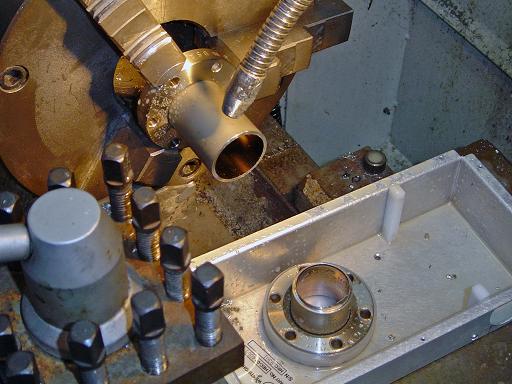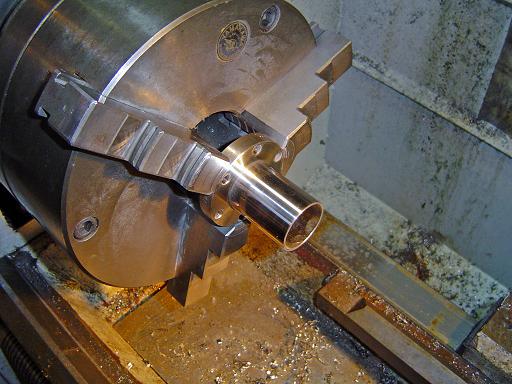Cleaning the Chamber 2
-
Jake Wells
- Posts: 87
- Joined: Tue Mar 18, 2014 9:29 pm
- Real name: Jake Wells
Cleaning the Chamber 2
I did a post a while ago about what to clean your chamber with. Most people recommended IPA instead of acetone but just recently i have bought this little flange off ebay and it looks really dirty and old. Is their any to polish it to get some of the dirt or grime off it.

“The day science begins to study non-physical phenomena, it will make more progress in one decade than in all the previous centuries of its existence.”
― Nikola Tesla
― Nikola Tesla
- Chris Bradley
- Posts: 2930
- Joined: Fri May 02, 2008 7:05 am
- Real name:
Re: Cleaning the Chamber 2
I'd recommend seeing if you could find someone with an ultrasonic bath. If they have a good one then they will likely have access to an appropriate solvent to bath it in.
Be cautious about any deposits on vacuum stuff that you don't know what it is. Lots of vacuum parts are used with toxic processing chemicals, so you don't really know what you're getting in this condition.
Be cautious about any deposits on vacuum stuff that you don't know what it is. Lots of vacuum parts are used with toxic processing chemicals, so you don't really know what you're getting in this condition.
-
Rapp Instruments
- Posts: 92
- Joined: Mon Mar 23, 2009 7:22 pm
- Real name: Thomas Rapp
- Contact:
Re: Cleaning the Chamber 2
Hi Jake,
in my work we have cleaned used vacuum devices with a warm (~50°C) solution of citric acid in water.
Thomas
in my work we have cleaned used vacuum devices with a warm (~50°C) solution of citric acid in water.
Thomas
-
Jake Wells
- Posts: 87
- Joined: Tue Mar 18, 2014 9:29 pm
- Real name: Jake Wells
Re: Cleaning the Chamber 2
If i do find a person with a ultrasonic bath what other solovents could i clean it with?
If i cant find a ultrasonic bath is their any other wat to get some of the dirt and grime off and polish it up? Would wiping the chamber with acetone and polishing it like Andrew Seltzman did?


http://www.rtftechnologies.org/physics/ ... sphere.htm
If i cant find a ultrasonic bath is their any other wat to get some of the dirt and grime off and polish it up? Would wiping the chamber with acetone and polishing it like Andrew Seltzman did?
http://www.rtftechnologies.org/physics/ ... sphere.htm
“The day science begins to study non-physical phenomena, it will make more progress in one decade than in all the previous centuries of its existence.”
― Nikola Tesla
― Nikola Tesla
- Chris Bradley
- Posts: 2930
- Joined: Fri May 02, 2008 7:05 am
- Real name:
Re: Cleaning the Chamber 2
It is generally best to know what the contaminations are before you attempt to clean it. But the advantage of an ultrasonic bath is that whatever much is there is dislodged by a physical (mechanical) action rather than a chemical one. A bath of the right solvent to solvate the specific contamination is, obviously, ideal but you can start with environmentally benign solvents before you start hammering it with stuff that needs managed disposal.
Try water first, it is the perfect solvent if the substance for cleaning is water soluble! Then isopropanol if it doesn't clean well with water. If it is an oily residue you can try a mild acid as Thomas has suggested, or try D-limonene which is a good, environmentally friendly alternative to di- and tri-clorinated substances. You get increasingly more expensive and less convenient disposal routes as you increase the power of the solvent.
Try water first, it is the perfect solvent if the substance for cleaning is water soluble! Then isopropanol if it doesn't clean well with water. If it is an oily residue you can try a mild acid as Thomas has suggested, or try D-limonene which is a good, environmentally friendly alternative to di- and tri-clorinated substances. You get increasingly more expensive and less convenient disposal routes as you increase the power of the solvent.
-
Jerry Biehler
- Posts: 975
- Joined: Tue Nov 24, 2009 3:08 am
- Real name:
- Location: Beaverton, OR
Re: Cleaning the Chamber 2
Don't worry about exterior surfaces. It does not matter what they look like. Just give the parts a good wipe down and use them. You can use fine scotchbrite to clean things up too. When using it make sure you move the pad in a direction radial to the tubing for o-ring type seals.
-
Jake Wells
- Posts: 87
- Joined: Tue Mar 18, 2014 9:29 pm
- Real name: Jake Wells
Re: Cleaning the Chamber 2
Would it be safe to scrub acetone or IPA using the fine scotchbrite sponge. or should IPA and acetone just be used with a lint free rag?
“The day science begins to study non-physical phenomena, it will make more progress in one decade than in all the previous centuries of its existence.”
― Nikola Tesla
― Nikola Tesla
-
John Futter
- Posts: 1850
- Joined: Wed Apr 21, 2004 10:29 pm
- Real name: John Futter
- Contact:
Re: Cleaning the Chamber 2
Jake
Just put in the kitchen sink with normal detergent and give it a good scrub inside and out
with plastic brush. For a newcomer to vacuum I would not use anything abrasive.
rinse in warm water and put in oven @ 250F or 120C for one hour.
This is all that is needed for amateur vacuum especially fusor type vacuums
professionals use the same but the detergent is DECON90 which we use for 10 ^ -9 or better vaccums
Just put in the kitchen sink with normal detergent and give it a good scrub inside and out
with plastic brush. For a newcomer to vacuum I would not use anything abrasive.
rinse in warm water and put in oven @ 250F or 120C for one hour.
This is all that is needed for amateur vacuum especially fusor type vacuums
professionals use the same but the detergent is DECON90 which we use for 10 ^ -9 or better vaccums
- Dennis P Brown
- Posts: 3189
- Joined: Sun May 20, 2012 10:46 am
- Real name: Dennis Brown
Re: Cleaning the Chamber 2
Mr. Bradley is correct - for all you know the surface has arsenic on it or some toxic organic (in which case a detergent/water cleaning is a good idea.) However, following standard safe operating procedures you can clean even toxic surfaces with a reasonable degree of safety. Use disposal-able gloves that can handle your solvents (!) and do not clean it in your house but outside. Wear proper safety eye covers (goggles are best) - I cannot tell you the number of times my solvents have, somehow, managed to splash toward my face. Throw away the container used to hold the item and waste solvent. As for acetone, that is a very safe solvent (with gloves and used outside) and an excellent first cleaning solvent; IPA can be used after acetone with good results. A water/detergent cleaning should be avoided for any high vacuum parts but if done, you really need to then wash it out with ethanol, and then allow to air dry. This should be followed by another cleaning with the two organic solvents to remove the trace detergents. Using any abrasive method can be done only for non-sealing surfaces. Do not use any abrasive where the part will seal with a gasket/O-ring surface. Be careful that those surfaces have no scratches. A very mild acid solution can work but could also create large numbers of microscopic pits that will making out gassing an issue; not critical for a fusor but for high vac use, could be a concern.
That all said and done, unless the part has grease or oil, I would avoid cleaning it altogether since solid coatings (except for metals like Zinc) tend not to be an issue at moderate vacuum levels (above 10^-3 torr). Just my opinion but I never clean any vacuum parts unless it has grease/oil contamination. But your system, your call. As for cleaning the outside of the component, really anything is fine. Baking, as Mr. Futter indicates, is a good idea to remove trace water but only after cleaning away any trace detergent with some alcohol first! Otherwise, baking in trace detergent might be counter productive ... .
That all said and done, unless the part has grease or oil, I would avoid cleaning it altogether since solid coatings (except for metals like Zinc) tend not to be an issue at moderate vacuum levels (above 10^-3 torr). Just my opinion but I never clean any vacuum parts unless it has grease/oil contamination. But your system, your call. As for cleaning the outside of the component, really anything is fine. Baking, as Mr. Futter indicates, is a good idea to remove trace water but only after cleaning away any trace detergent with some alcohol first! Otherwise, baking in trace detergent might be counter productive ... .
